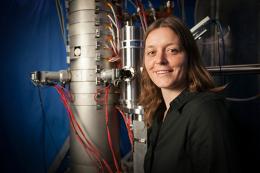Lena Kourkoutis

Breaking rules to see below (and at) the surface
“What drew me to physics initially is still what drives me today. It is curiosity,” says Lena Kourkoutis. “If I can use my microscope to help solve a mystery, I get excited.” Kourkoutis, an assistant professor and Rebecca Q. and James C. Morgan Sesquicentennial Faculty Fellow in Cornell Engineering’s School of Applied and Engineering Physics, has had much to be excited about lately.
Kourkoutis and her research group use state-of-the-art electron microscopy techniques to look closely at the microscopic properties of the next generation of energy materials. “Our research is driven by trying to understand how things work,” says Kourkoutis. “New energy conversion and storage technologies have many complex interfaces, such as those between the electrodes and the electrolyte in rechargeable batteries. We are using electron microscopy to figure out what is going on at these interfaces.” In order to maximize the effectiveness of batteries and photovoltaic devices, for example, it is important to know exactly what is happening at the surfaces of the nanostructured materials these things are made of.
“If we can resolve the interface in a battery at atomic resolution and see how the chemistry changes from the interface into the electrolyte,” says Kourkoutis, “we can better understand the processes occurring and help figure out how to make batteries more efficient and durable.”
When asked how she ended up in physics, Kourkoutis says, “My father is a physicist and I have always enjoyed math and science. When it was time to choose my major I went through the list and ended up crossing everything else out until I was left with physics.” Kourkoutis received her ‘Diplom’ degree in physics from the University of Rostock in Germany in 2003. She then studied at Cornell, where she earned both her Master’s and her Ph.D. in applied and engineering physics. Between her graduate student years at Cornell and her faculty position at Cornell, Kourkoutis went to Martinsried, Germany, where she explored cryo-electron microscopy in the Molecular Structural Biology Group at the Max Planck Institute of Biochemistry (MPIB).
Building her skills with cryo-electron microscopy has greatly expanded the opportunities for Kourkoutis to collaborate with engineers and physical scientists outside of the School of Applied and Engineering Physics. “That was a conscious choice I made,” says Kourkoutis. “Before I started my faculty position I had two years to explore a new area that I was not exposed to during my Ph.D. I joined Wolfgang Baumeister’s lab at the MPI and built up my knowledge of biology and cryo-electron microscopy.”
Usually, there is a strong divide between electron microscopy for the life sciences and electron microscopy for the physical sciences, but Kourkoutis breaks this rule. Kourkoutis is able to navigate both sides of this divide. “The microscopes I work with can image materials at the atomic scale,” says Kourkoutis. “They let me see which atoms are sitting where. This ability is useful to both life scientists and physical scientists.”
Kourkoutis and her lab are pushing the edges of what we know about interactions that happen at all kinds of important interfaces. As new high-tech nano-materials are developed and used in a variety of applications, Kourkoutis is using her electron microscope to see what is happening at the place where these materials come into contact with other materials. “In order to explore a new range of phenomena and materials,” says Kourkoutis, “we are developing low temperature high-resolution electron microscopy techniques. With these methods we can look at novel phases that emerge at complex oxide interfaces at low temperatures. We can examine the solid-liquid and hard-soft interfaces in next generation photovoltaics, batteries, and fuel cells. And we can also image organic/inorganic interfaces in biomaterials and learn in detail what is happening there.”
Another advantage of applying electron microscopy at cryogenic temperatures is the ability to study biological systems in their near-native environments. Kourkoutis can image the molecular structure and organization of biological systems and by doing so can add to the current understanding of cellular processes and the function of individual macromolecules. A biological sample can be prepared by plunge freezing it and then subsequently thining it layer by layer using focused-ion-beam (FIB) milling. Kourkoutis has used this method to take a very close look at a purple bacterium called Rhodobacter sphaeroides.
As she speaks about the capabilities of her microscope, even Kourkoutis sounds impressed. She understands how remarkable it is to be able to see things at the atomic level and she wants to share her amazement with her students. “I like teaching freshmen,” says Kourkoutis, “because they can get so excited. I also enjoy having undergraduates in my lab--research experiences are so important to their careers. I look at them as future colleagues.” The pairing of Lena Kourkoutis and the electron microscope seems like a marriage made in heaven—it is the perfect tool for someone with her boundless curiosity about what is happening at the atomic level. Says Kourkoutis, “All of the technological innovations we make are a result of seeing more clearly and answering some basic questions.”

